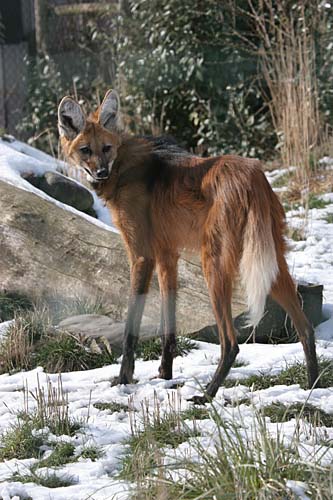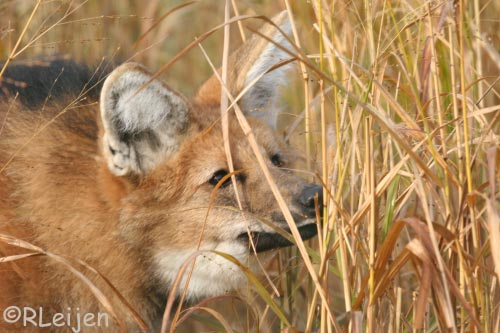|

Although it is a member of the Canedae family, which contains dogs, wolves,
and foxes, the maned wolf is the only species in the genus Chrysocyon. It is considered not to be a "true wolf". It looks
more to me like an overgrown fox because of the legs and tail, but somehow it is still concidered a wolf.
Ancestors
of the maned wolf are thought to have spread from North to South America about two million years ago. Broken away from other
wolf species in North America, the maned wolf evolved into what it is today.
The maned wolf stands up to 3 feet
in height, and 4 feet in length. It very seldom weighs over 50 pounds, though it's long legs make it appear to be much heavier.
By nature, it lives in dry, shrubby forests, and grasslands with swampy regions that grow high, lush vegitation. The wolf's
long legs enable it to see above tall grass, making it easy to spot prey as well as hide from it. The wolf's toes can also
be splayed apart, allowing it to walk on marshy grounds. The maned wolf is a flesh eater like all other dogs, although fruits
make up about half of its diet. Its favorite food is the wild guinea pig found in its area. It will eat rabbits, rodents,
lizards, frogs, birds, fish, and snails. It has sharp teeth for

tearing meat, and broad flat molars for crushing fruit. It hunts mainly at dusk
and at night. It catches its prey with a swift, high pounce. Occasionally, it digs creatures out their burrows.
Breeding Season falls between late Spring and early Summer. Its mating habits have been observed only
in captivity. The female takes the lead in mating by bowing in front of the male and rubbing against him while pounding her
forepaws on the ground. The female gives birth to four to five cubs in her den. The cubs are fully grown in about a year,
and usually mate after they are two years old. Captive maned wolves live between 12-15 years. Their lifespan is unknown in
the wild.
The maned wolf is native to Brazil, northern Argentina, Paraguay, eastern Bolivia and southeastern Peru.
Habitat destruction through agricultural development threatens maned wolves. The effects of agriculture --overgrazing by cattle,
annual burning of pasture and soil erosion -- leave less food and territory for maned wolves. They are killed by ranchers
when they are forced to feed on ranchers' livestock. They are listed as an endangered species by the U.S. Fish & Wildlife
Service and by the Brazilian Government.
|

